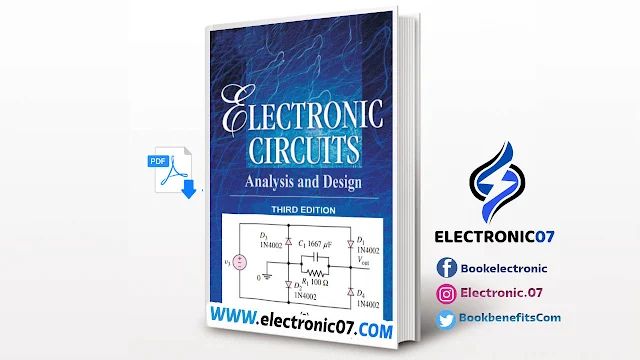"Electronic Circuit Analysis and Design: Your Guide to the PDF"
Introduction:
"Electronic Circuits Analysis and Design" in PDF format is your gateway to mastering the intricacies of electronic circuits. Authored by Donald A. Neamen, this book is a highly acclaimed resource for undergraduate students majoring in electrical and electronics engineering. In this SEO-optimized rendition, we delve into the key facets of this invaluable book, making it easier for you to explore and comprehend its contents.
"Electronic Circuit Analysis and Design" by Donald A. Neamen is a well-regarded textbook tailored for undergraduate students venturing into the realm of electrical and electronics engineering. This book encompasses a wide spectrum of electronic circuit-related topics, encompassing circuit analysis, circuit theorems, operational amplifiers, diodes, bipolar junction transistors, field-effect transistors, digital logic circuits, and more.
The book is distinguished by its lucid and concise elucidation of intricate concepts, complemented by a plethora of examples and practical applications that illustrate theoretical principles. It also features a range of valuable aids, including review questions, problem-solving solutions, and design illustrations, all of which facilitate the reinforcement of students' understanding of the subject matter.
In essence, "Electronic Circuit Analysis and Design" stands as a comprehensive and well-articulated textbook that lays a strong foundation for students keen on mastering the fundamentals of electronic circuit analysis and design.
Philosophy and Goals:
"Electronic Circuit Analysis and Design" serves as a core text in electronics, catering to undergraduate electrical and computer engineering students. The book's third edition is specifically designed to provide a fundamental framework for analyzing and designing both analog and digital electronic circuits.
While contemporary electronic circuit design predominantly revolves around integrated circuits (ICs), initially, the book delves into the analysis and design of discrete transistor circuits. It gradually increases the complexity of the circuits studied, enabling readers to ultimately analyze and design the basic components of integrated circuits, including digital logic gates.
This text serves as an introduction to the intricate world of electronic circuits and does not delve into more advanced material or specific technologies, such as gallium arsenide. Furthermore, it does not address the layout and fabrication of ICs, as these topics warrant dedicated texts of their own.
Computer-Aided Analysis and Design (PSPICE):
In today's electronics landscape, computer analysis and computer-aided design (CAD) play pivotal roles. One prominent electronic circuit simulation program is the Simulation Program with Integrated Circuit Emphasis (SPICE), developed at the University of California. This text includes a comprehensive appendix on the PSpice circuit modeling program, with example programs featured in Appendix B. Instructors have the flexibility to introduce PSpice at any juncture during the course.
While the text predominantly emphasizes manual analysis and design, it does incorporate PSpice results in various sections, aligning them with manual analysis outcomes. Schematic diagrams from PSpice capture and computer simulation results are incorporated as well. Specific computer simulation problems are integrated at the end of most chapters, serving as an optional tool to validate manual analysis results. In certain chapters, particularly those covering frequency response and feedback, computer analysis plays a more substantial role. Nevertheless, computer analysis is introduced only after fundamental circuit properties have been thoroughly covered. Computers are aids that enhance electronic circuit analysis and design but should not replace a comprehensive grasp of circuit analysis fundamentals.
Design Emphasis:
Design is the essence of engineering, and effective design arises from a robust foundation of analysis. Throughout the text, we highlight various circuit characteristics and properties during analysis to nurture an intuitive understanding applicable to the design process. Abundant design examples, design exercises, and end-of-chapter design problems are featured. While some design problems have specifications leading to unique solutions, true engineering design typically involves non-unique solutions. While the design problems in the text may not embody the purest form of design, they serve as initial steps in comprehending the design process. In the end-of-chapter problems, you'll find a separate section called "Design Application" housing open-ended design challenges.
Prerequisites:
This book targets junior undergraduates majoring in electrical and computer engineering. Prerequisite knowledge encompasses the dc and steady-state sinusoidal analysis of electric circuits, transient analysis of RC circuits, and various network concepts, including Thevenin's and Norton's theorems. Familiarity with Laplace transform techniques can be advantageous. Pre-existing knowledge of semiconductor device physics is not mandated.
The book is structured into three parts:
Part 1 (Chapters 1-8) covers semiconductor materials, basic diode operations, diode circuits, field-effect transistors (with an emphasis on MOSFETs), and basic FET linear amplifiers.
Part 2 explores advanced analog electronics, including operational amplifier circuits, biasing techniques used in integrated circuits, and various other analog circuit applications.
Part 3 delves into digital electronics, encompassing CMOS integrated circuits.
The text also includes six appendices for additional reference.
In closing, "Electronic Circuit Analysis and Design" offers a comprehensive resource for students in the field of electrical and electronics engineering, guiding them through the intricate world of electronic circuits.
Contents Of The Book:
PROLOGUE I
PROLOGUE TO ELECTRONICS 1
Brief History 1
Passive and Active Devices 2
Electronic Circuits 2
Discrete and Integrated Circuits 2
Analog and Digital Signals 3
Notation 3
Summary 4
PART 1 SEMICONDUCTOR DEVICES AND BASIC APPLICATIONS 5
Chapter 1 Semiconductor Materials and Diodes 7
Chapter 2 Diode Circuits 61
Chapter 3 The Field-Effect Transistor 119
Chapter 4 Basic FET Amplifiers 207
Chapter 5 The Bipolar Junction Transistor 287
Chapter 6 Basic BJT Amplifiers 369
Chapter 7 Frequency Response 471
Chapter 8 Output Stages and Power Amplifiers 561
PART 2 ANALOG ELECTRONICS 619
Chapter 9 Ideal Operational Amplifiers and Op-Amp Circuits 621
Chapter 10 Integrated Circuit Biasing and Active Loads 683
Chapter 11 Differential and Multistage Amplifiers 749
Chapter 12 Feedback and Stability 847
Chapter 13 Operational Amplifier Circuits 943
Chapter 15 Applications and Design of Integrated Circuits 1055
PART 3 DIGITAL ELECTRONICS 1137
Chapter 16 MOSFET Digital Circuits 1139
Chapter 17 Bipolar Digital Circuits 1249
Information Of The Book:
Title: Electronic circuits analysis and design Download PDF
Size: Mb
Pages: 1376
Year : 2007
Format: PDF
Language : English
Author: Donald A. Neamen

